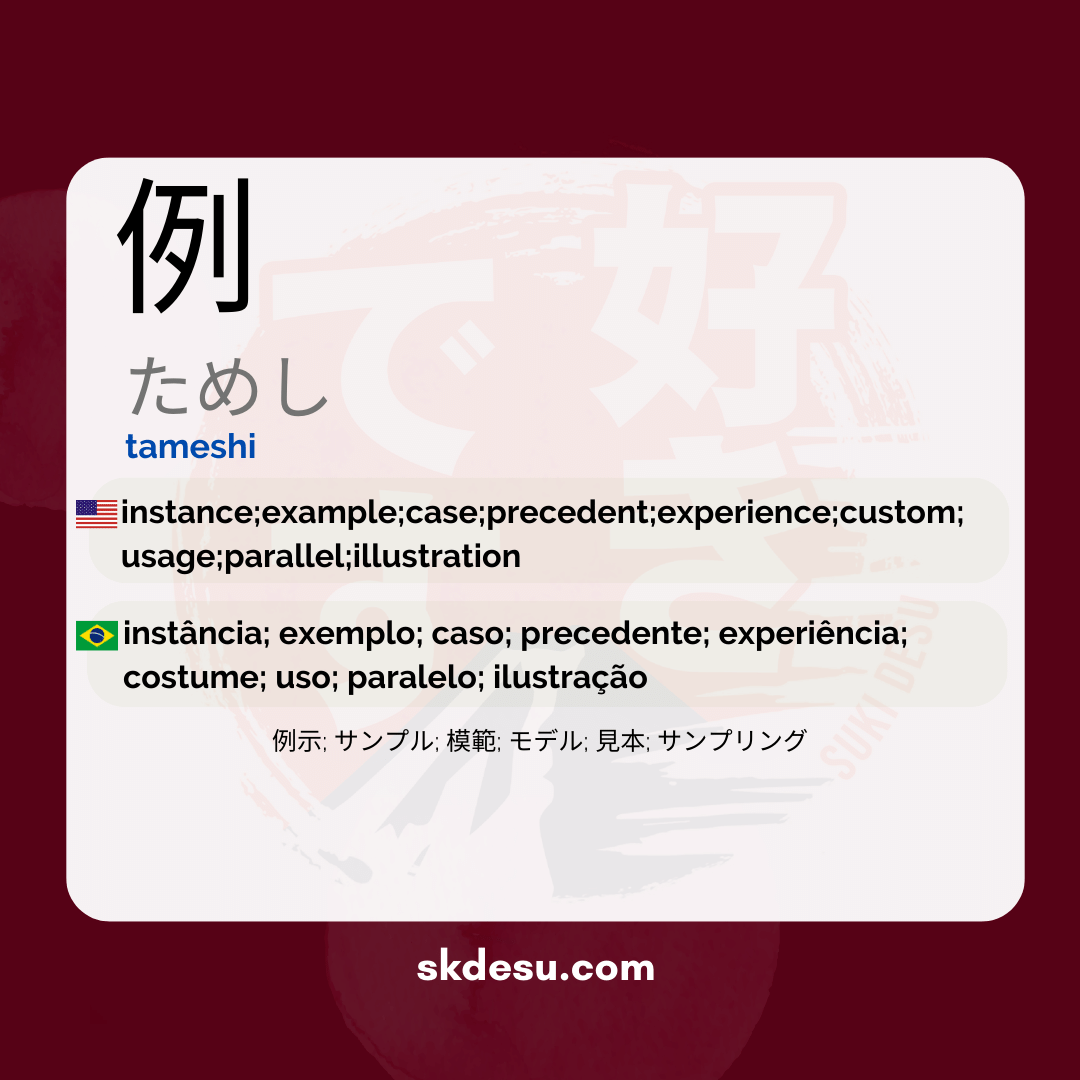Translation and Meaning of: 例 - tameshi
The Japanese word 例 [ためし] is an interesting term that can cause some confusion among Japanese learners. Its main meaning is related to "example" or "test," but its application goes beyond that. In this article, we will explore what this word represents, how it is used in everyday Japanese, and some tips for memorizing it correctly. If you have ever wondered how the Japanese use 例 in different contexts, keep reading to find out.
Meaning and use of 例 [ためし]
The term [ためし] can be translated as "example" or "case," but it also carries nuances of "test" or "experience." One of the most common ways to use it is in situations where someone wants to verify something in practice. For instance, when trying out a product before purchasing, a Japanese person might say "ためしに使ってみる" (I'll try using it to test).
Moreover, this word appears in expressions like "ためしにやってみる" (I'll try doing it to see). This usage reinforces the idea of experimentation, something that goes beyond the simple "example." It is worth noting that, although the kanji 例 is often read as "rei" (as in 例文 [れいぶん] - example sentence), the reading "ためし" has a more colloquial and practical tone.
Origin and curiosities about the word
The kanji 例 is composed of the radical 亻 (person) and 列 (row, line), suggesting the idea of something that serves as a reference for others. The reading "ためし" has ancient roots in Japanese and is associated with the verb "試す" (ためす - to test). This connection explains why the word carries both the meaning of "example" and "test."
An interesting detail is that 例 [ためし] is not an extremely common word in everyday life, but it frequently appears in specific contexts, such as in stores (when offering tastings) or in informal situations among friends. Unlike "rei," which is more formal, "ためし" has a more casual and direct usage.
Tips for memorizing and using correctly
An effective way to reinforce the meaning of 例 [ためし] is to associate it with experimentation situations. Think of moments when you try something new, like a piece of clothing or an app. Phrases such as "ためしに着てみる" (I'll try it on) can help you internalize the term. Another tip is to practice with real examples, like advertisements that offer "ためし飲み" (tasting drinks).
It is important to note that, although "ためし" and "rei" share the same kanji, they are not interchangeable. While "ためし" is used for practical actions and tests, "rei" appears in more formal constructions, such as 例題 (れいだい - example problem). Knowing when to use each reading will prevent confusion in communication.
Vocabulary
Expand your vocabulary with related words:
Synonyms and similar words
- 例示 (Reiji) - Example, specific illustration of a concept or item.
- サンプル (Sanpuru) - Sample, usually used for products or items that represent a larger piece.
- 模範 (Mohan) - Model or ideal example, often used to refer to standards of behavior.
- モデル (Moderu) - Model, used to represent something in fields such as design or manufacturing.
- 見本 (Mihon) - Example display, often used in market contexts or product exhibitions.
- サンプリング (Sanpuringu) - Sampling, the process of collecting samples for analysis or presentation.
Related words
Romaji: tameshi
Kana: ためし
Type: noun
L: jlpt-n3
Translation / Meaning: instance; example; case; precedent; experience; custom; use; parallel; illustration
Meaning in English: instance;example;case;precedent;experience;custom;usage;parallel;illustration
Definition: Selected word: cachorro Definition: A dog is a mammal belonging to the canine family and is often kept by humans as a pet or guard animal.
Quick Access
- Vocabulary
- Writing
- Sentences
How to Write in Japanese - (例) tameshi
See below a step-by-step guide on how to write the word by hand in Japanese. (例) tameshi:
Example Sentences - (例) tameshi
See below some example sentences:
Kanrei ni shitagatte koudou suru
Act according to tradition.
Act according to customs
- 慣例 (kanrei) - costume, common practice
- に (ni) - particle that indicates action or state in accordance with the previous term
- 従って (shitagatte) - according to, following
- 行動する (koudou suru) - act, take action
Jitsurei wo mite kara handan shite kudasai
Please make a judgment after seeing a real example.
Please judge after looking at the examples.
- 実例 - Example
- を - direct object particle
- 見て - ver (-te form of the verb)
- から - time particle, indicates that the action takes place after something
- 判断して - judge, decide (-te form of the verb)
- ください - please make a request
Mae rei wo sankou ni shite kudasai
Please refer to the previous example for reference.
See precedent.
- 前例 - It means "previous example" or "precedent".
- を - object particle.
- 参考 - It means "reference" or "consultation".
- に - Destination particle.
- してください - an expression that means "please do".
Regai ga hassei shimashita
An exception occurred.
Exception occurred.
- 例外 - means "exception" in Japanese.
- が - Grammatical particle that indicates the subject of the sentence.
- 発生 - means "occurrence" or "appearance" in Japanese.
- しました - past form of the verb "suru", which means "to do" or "to occur".
Kanojo wa taiyō no yō ni kagayaku to tatoerareru
It is compared to a bright sun.
It is compared to shine like the sun.
- 彼女 (kanojo) - she
- は (wa) - Topic particle
- 太陽 (taiyou) - Sun
- の (no) - Possessive particle
- ように (you ni) - As, similar to
- 輝く (kagayaku) - shine
- と (to) - Quote particle
- 例えられる (tatoerareru) - be compared, be described as
Other Words of this Type: noun
See other words from our dictionary that are also: noun

